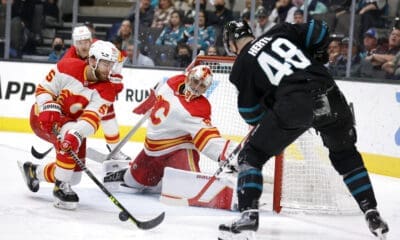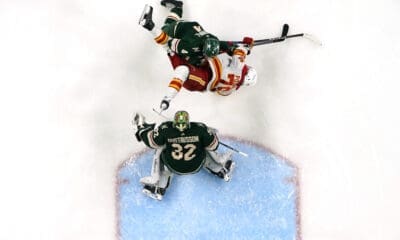Calgary Flames
Calgary Flames at Vancouver Canucks stats recap: And lo, the third period returns
The Calgary Flames reminded us of their 2014-15 selves with their first third period comeback of the season. It only took two games this time, and it was magnificent.

Remember the mythos surrounding the Calgary Flames last season? You could never count them out. They had 10 third period comebacks on the year, which actually wasn’t the most in the NHL – but it was just enough to build a narrative. If the Flames are down heading into the third, the opposing team had best watch out for them, because they will come back.
The Vancouver Canucks did not watch out for the Flames.
First, the two teams traded powerplay goals; then, even strength goals – although the Flames' didn't come until the fabled third, when they really had to put the pressure on to get it. And man oh man, was that pressure noticeable. On the ice, yes – the Flames thoroughly exhausted the Canucks – and in the stats charts. This surge was undeniable.
Via HockeyStats.ca, the game's full corsi chart:
A relatively evenly-played game – even during the Flames' terrible second period – that saw them annihilate the Canucks in the third. It really wasn't even close. The corsis were 20-10 in Calgary's favour.
At the same time, the Flames were lucky they got the overtime goal. They didn’t get any shot attempts until right at the very end; prior to that, they were really reliant on Jonas Hiller keeping them in the game. (And he did! Rather well!)
The tale wasn't too different at 5v5, either:
The Flames had the only powerplay in the first; and the Canucks, the only one in the third. The middle frame contained a ton of offsetting penalties, but also ultimately saw the Canucks with the +1 in powerplay advantages – the Flames took two solo penalties, and the Canucks just one.
Still, the same general tale from the overall game was followed when you discount special teams. Vancouver just has a much longer flatline from about the 30 minute mark until right before the Flames dominated.
It's also a demonstration of just how important it is to shut teams down when they have the man advantage. If they aren't generating anything at even strength, then the powerplay is probably their next best hope. Don't let them turn that hope into something tangible! The Flames failed on their first kill of the night – which only lasted 12 seconds – but succeeded every other time it came up.
Here are all of the shot attempts, visualized via War on Ice:
- Crash the net! The Flames went all in on going down the middle, and it paid off for them, twice. Dougie Hamilton’s goal being the outlier here – a hell of a blast from the point.
- The Canucks, on the other hand, were restricted to the outsides, and weren’t in prime scoring position as much as the Flames.
- And because it’s the Flames, blocked shots are going to come up: and the Canucks had to block waaaay more shots. They blocked 22 to the Flames’ 11; a direct result of the Flames forcing for better shooting lanes.
Via NaturalStatTrick (and War on Ice for scoring chance data), let's look at some of the Flames' individual fancier data (sorted by their time on ice):
| Player | TOI | iHSC | iSC | CF% | CF% ES | OZone Start% ES |
| Dougie Hamilton | 26:38 | 0 | 1 | 44.68% | 48.72% | 55.00% |
| Mark Giordano | 26:29 | 0 | 3 | 48.94% | 53.85% | 55.00% |
| Dennis Wideman | 25:38 | 0 | 0 | 57.78% | 53.85% | 62.50% |
| Kris Russell | 24:46 | 0 | 2 | 47.50% | 47.37% | 62.50% |
| Sean Monahan | 23:18 | 1 | 3 | 55.32% | 52.63% | 63.16% |
| Johnny Gaudreau | 21:10 | 3 | 4 | 68.18% | 63.16% | 70.59% |
| Jiri Hudler | 17:27 | 2 | 4 | 71.43% | 67.74% | 70.59% |
| Michael Frolik | 17:03 | 2 | 3 | 71.88% | 74.19% | 25.00% |
| Matt Stajan | 16:44 | 0 | 0 | 29.03% | 32.00% | 42.86% |
| Sam Bennett | 14:22 | 1 | 2 | 76.67% | 75.86% | 0.00% |
| Mason Raymond | 13:56 | 2 | 5 | 64.52% | 63.33% | 33.33% |
| Micheal Ferland | 13:00 | 1 | 1 | 56.52% | 41.18% | 45.45% |
| David Jones | 11:55 | 1 | 2 | 28.00% | 28.00% | 60.00% |
| Lance Bouma | 11:54 | 0 | 1 | 42.11% | 50.00% | 44.44% |
| Deryk Engelland | 10:13 | 0 | 2 | 76.00% | 75.00% | 25.00% |
| Mikael Backlund | 10:05 | 0 | 0 | 58.33% | 63.64% | 80.00% |
| Brett Kulak | 9:42 | 0 | 0 | 73.08% | 73.08% | 25.00% |
| Brandon Bollig | 6:37 | 1 | 1 | 72.73% | 72.73% | 75.00% |
Some standouts:
- Gaudreau led the charge with three high-danger scoring chances. Fitting he got the overtime winner! Of his four scoring chances on the night, three were especially terrifying for the opposition. He posted great possession stats, too, but did have the benefit of some good zone starts in order to do so.
- Hudler was right up there with him, while Monahan wasn’t too far behind himself.
- Raymond led the way with five individual scoring chances of his own, though. And he did it with low zone starts. He really, really wanted to prove he deserves to stay in the lineup – and he did just that.
- The entire Raymond – Bennett – Frolik line CRUSHED it. Especially when you consider their zone starts. Seriously, Bennett received no starts in the offensive zone at even strength, and he came away with the best possession stats of the night? That’s wild.
- Bennett’s most common opponents: Yannick Weber, Jannik Hansen, Jared McCann, Luca Sbisa, Brandon Prust. No particularly hard hitters.
- Give it up for the bottom guys: Engelland, Kulak, and Bollig all had outstanding possession games. Especially Kulak and Engelland, with their poor zone starts.
- Kulak played roughly the same competition Bennett did.
- Stajan and Jones had rough nights. Ferland fared a bit better.
- Ferland played 8:27 with Stajan, and 8:02 with Jones. He was a 42.86% CF player with them (at evens), and 33.33% without. He got a small boost by spending just under two minutes with Backlund and Bollig; he was 100% CF with them.
- Speaking of Backlund, he’s being criminally misused. Ten minutes in extremely sheltered circumstances for one of your best defensive players? That doesn’t seem right at all. He was just signed to a three-year, $3.575 million per contract – makes more sense to use him to the best of his abilities while you’ve got him, which is going to be for a while.
- Backlund, 4:54 with Bouma at even strength: 62.50% CF with, 66.67% CF without. Bouma: 62.50% CF with Backlund, 33.33% CF without. Bouma can’t function without Backlund.
by Ari Yanover









